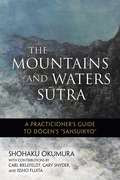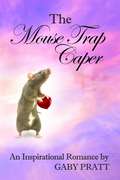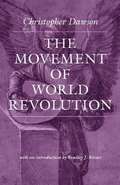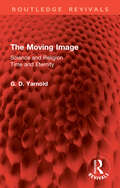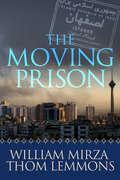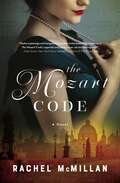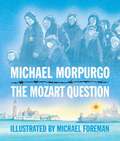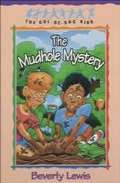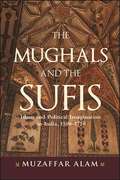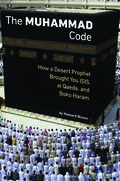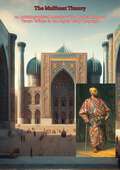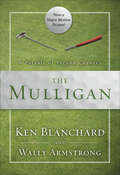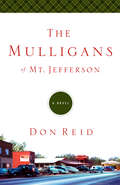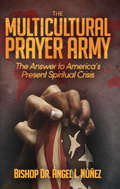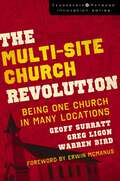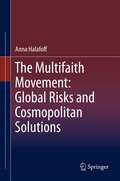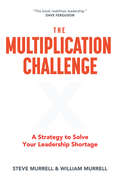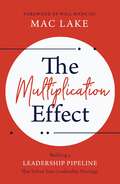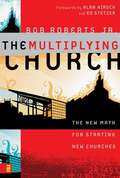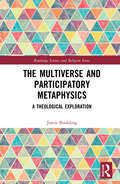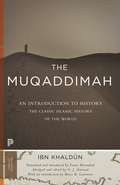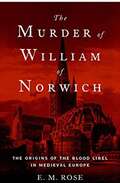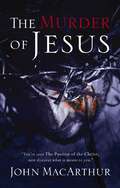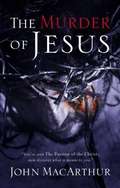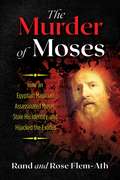- Table View
- List View
The Mountains and Waters Sutra: A Practitioner's Guide to Dogen's "Sansuikyo"
by Gary Snyder Shohaku Okumura Carl Bielefeldt Shodo Spring Issho FujitaAn indispensable map of a classic Zen text.“Mountains and waters are the expression of old buddhas.” So begins “Sansuikyo,” or “Mountains and Waters Sutra,” a masterpiece of poetry and insight from Eihei Dogen, the thirteenth-century founder of the Soto school of Zen. Shohaku Okumura—renowned for his translations of and magisterial teachings on Dogen—guides the reader through the rich layers of metaphor and meaning in “Sansuikyo,” which is often thought to be the most beautiful essay in Dogen’s monumental Shobogenzo. His wise and friendly voice shows us the questions Dogen poses and helps us realize what the answers could be. What does it mean for mountains to walk? How are mountains an expression of Buddha’s truth, and how can we learn to hear the deep teachings of river waters? Throughout this luminous volume, we learn how we can live in harmony with nature in respect and gratitude—and awaken to our true nature.
The Mouse Trap Caper
by Gaby PrattWhen it rains in Rain, Delaware, it pours. Nicknamed Mouse, Kerri Hill, Christian School teacher who moonlights as a barrel racer, can attest to it. Not only is some jerk threatening her off the circuit, she has lost her best friend, Kenny Prescott, in a rodeo accident. Like the hospital chaplain who had comforted her after her mother's passing, she goes on a similar mission to console Kenny's brother, Mark. Kenny would've wanted her to. Falling in love was not part of her plan. Kenny's last word to his brother was something about a mouse. Assuming he meant Kerri was his significant other, Mark vows to protect her from the brewing danger. Kenny would've wanted him to. Conscience ridden with guilt over his brother's death, now he has to watch his growing attraction to Mouse. When the threats take an ugly turn mouse traps are set, but is it Mark's heart that gets caught?
The Movement of World Revolution (Worlds of Christopher Dawson)
by Christopher DawsonThis book originally published in 1959, explores many of the themes Dawson considered most important in his lifetime: the religious foundation of human culture, the central importance of education for the recovery of Christian humanism, the myth of progress, and the dangers of nationalism and secular ideologies. Dawson's concern was not so much a solution to the political, social, or economic problems of his day, but rather an understanding of the present as it had evolved from the past as well as the charting of a path into the future. <P><P>In this work, Dawson argued that the modern period was "not a metaphysical age, and in the East no less than in the West men are more interested in subsistence and coexistence than in essence and existence." Dawson believed a reduction of culture to material and technological preoccupations would ultimately end in an impoverishment of life. His solution was a return to a renewed Christendom, one not marked by an alliance with secular powers but rather arising out of an organic, spiritual foundation. The Movement of World Revolution is remarkably prophetic in anticipating many of the contemporary struggles about the role of religion in the modern state.
The Moving Image: Science and Religion. Time and Eternity (Routledge Revivals)
by G. D. YarnoldResearch scientist and university teacher, Anglican clergyman and warden of a great theological library, the author had previously lectured and written extensively on religious and scientific questions. In The Moving Image, originally published in 1966, he deals with a number of related problems, some old and some new, on the borderland where science, philosophy and theology meet. How does our sense of time arise, and what does it mean? Is the universe an accident and human life without purpose, or is a doctrine of creation a necessary counterpart to the teachings of evolution? What does it mean in a scientific age to claim that the eternal God works out his purpose in cosmic and organic process, revealing himself in human history? Does the classical doctrine of the Incarnation do justice to Christ’s involvement as a human person in the travail of the real world as we know it?These and other questions are looked at afresh in the light of a carefully articulated understanding of the relation of time to eternity, which draws together the contributions of the ancient world, the insights of existentialists and linguistic philosophy, and the most recent trends in natural science. On this basis, skilfully argued and cogently presented, the author examines the problems of divine omniscience in relation to human freewill and neurophysiological determinism, and deals in a fresh manner with the great questions of Christology and the hope of eternal life. The result is a work of fascinating interest, in which bold metaphysical views are advanced with full awareness of the pitfalls to which such thinking was exposed at the time. Of interest to philosophers and theologians at the time, as well as the lay reader, today it can be read in its historical context.
The Moving Prison
by Thom Lemmons William MirzaThe year is 1979 and Ezra Solaiman and his family are trapped in a country in turmoil. Their homeland is increasingly ruled by Islamic fundamentalists who are becoming a law unto themselves. The Solaimans plan their escape only to have Ezra captured and imprisoned on trumped-up charges. Unsure just who his enemies are, Ezra is desperate for a way out--out of prison, out of Iran, out of the chaos his life has become. The Moving Prison is a riveting tale of revolution and revelation, of failure ... and faith.
The Mozart Code
by Rachel McMillanNo matter how you might try to hide in a war to escape your past, it is always close at hand.Lady Sophia Huntington Villiers is no stranger to intrigue, as her work with Alan Turing&’s Bombe Machines at Bletchley Park during the war attests. Now, as part of Simon Barre&’s covert team in post-war Vienna, she uses her inimitable charm and code name Starling to infiltrate the world of relics: uncovering vital information that could tilt the stakes of the mounting Cold War. When several influential men charge her with finding the death mask of Mozart, Sophie wonders if there is more than the composer&’s legacy at stake and finds herself drawn to potential answers in Prague.Simon Barrington, the illegitimate heir of one of Sussex&’s oldest estates, used the previous war to hide his insecurities about his past. Now, he uses his high breeding to gain access to all four allied quarters of the ruined city in an attempt to slow the fall of the Iron Curtain. He has been in love with Sophie Villiers since the moment he met her, and a marriage of convenience to save Simon&’s estate has always kept her close. Until now, when Sophie&’s mysterious client in Prague forces him to wonder if her allegiance to him—and their cause—is in question. Torn between his loyalty to his cause and his heart, Simon seeks answers about Sophie only to learn that everything he thought he knew about his involvement in both wars is based on a lie.&“Murky espionage and burgeoning passion twine beautifully together in The Mozart Code&’s superbly evocative prose—an enchanting read!&” —Kate Quinn, New York Times bestselling author of The Rose Code&“Vienna is the new Paris in The Mozart Code, a World War II spy novel with deft, chess-like plotting, and plenty of old-fashioned romance.&” —Susan Elia MacNeal, New York Times bestselling author of the Maggie Hope novels and Mother Daughter Traitor Spy&“The Mozart Code is a smart, luscious romance, a thrilling suspense, and a thunderously good read. McMillan is a rising star in historical fiction.&” —Aimie K. Runyan, bestselling author of The School for German Brides&“Rife with secret codes, haunting melodies, betrayal and sacrifice, at its heart this is a story about the courage it takes to love and be loved. Highly recommended!&” —Kimberly Brock, author of The Lost Book of Eleanor Dare&“Beautifully lush and atmospheric, The Mozart Code is a novel full of nuances and brimming with danger, romance, and intrigue.&” —Jenni L. Walsh, author of Becoming Bonnie and The Call of the Wrens&“The Mozart Code left me breathless.&” —Joy Callaway, international bestselling author of The Fifth Avenue Artists Society and The Greenbrier ResortPost World War II historical romanceStand-alone novel (features characters from The London Restoration)Book length: 95,000 wordsIncludes discussion questions for book clubs
The Mozart Question
by Michael MorpurgoA boy's passion for music unlocks a painful secret and draws his family together in a multilayered tale. Like any young boy, Paolo becomes obsessed with what he can't have-- in his case, a violin.
The Mudhole Mystery (The Cul-de-Sac Kids #10)
by Beverly LewisDunkum's persistence in digging out a mysterious object that he discovers in a mudhole yields some interesting information about previous residents in the neighborhood.
The Mughals and the Sufis: Islam and Political Imagination in India, 1500–1750
by Muzaffar AlamExamines the relationship between Mughal political culture and the two dominant strains of Islam's Sufi traditions in South Asia: one centered around orthodoxy, the other focusing on a more accommodating and mystical spirituality.Based on a critical study of a large number of contemporary Persian texts, court chronicles, epistolary collections, and biographies of sufi mystics, The Mughals and the Sufis examines the complexities in the relationship between Mughal political culture and the two dominant strains of Islam's Sufi traditions in South Asia: one centered around orthodoxy, the other focusing on a more accommodating and mystical spirituality. Muzaffar Alam analyses the interplay of these elements, their negotiation and struggle for resolution via conflict and coordination, and their longer-term outcomes as the empire followed its own political and cultural trajectory as it shifted from the more liberal outlook of Emperor Akbar "The Great" (r. 1556–1605) to the more rigid attitudes of his great-grandson, Aurangzeb 'Alamgir (r. 1658–1701). Alam brings to light many new and underutilized sources relevant to the religious and cultural history of the Mughals and reinterprets well-known sources from a new perspective to provide one of the most detailed and nuanced portraits of Indian Islam under the Mughal Empire available today.
The Muhammad Code: How a Desert Prophet Brought You ISIS, al Qaeda, and Boko Haram
by Howard Bloom"If Howard Bloom is only ten percent right, we'll have to drastically revise our notions of the universe through the contagious joy of a great mind set loose on the biggest intellectual puzzles humans have ever faced. Whether you're a scientist or hyper-curious layperson, Bloom's argument will rock your world." -- Barbara Ehrenreich on Howard Bloom's The God ProblemOsama bin Laden called Mohammad "a Prophet of Conquest." Pakistan's Universal Sunnah Foundation brags that under Mohammad's battlefield leadership, "Islam spread an average of 317 square miles per day."Right now ISIS, al Qaeda, Boko Haram, and the Supreme Leader of Iran know that Islam toppled two of the biggest superpowers in history--Rome and Persia--then took over two-thirds of the inhabited world. Militant Muslims believe that Islam is on the brink of doing it again. The Muhammad Code: How a Desert Prophet Brought You ISIS, al Qaeda, and Boko Haram lays bare the origins of this profoundly dangerous belief.Many contemporary thinkers excuse Islamic violence as a legitimate reaction to Western imperialism. They blame America's wars in Iraq and Afghanistan and the establishment of Israel in 1948. But Jihad was invented in 624 AD by the only prophet ever to call himself "The Prophet of War." And that prophet was not responding to "legitimate grievances," but an ambition for world conquest.
The Mulfuzat Timury, or, Autobiographical Memoirs of the Moghul Emperor Timur: Written In The Jagtay Turky Language (classic Reprint)
by Timur“The Mughal emperor Timur (1336–1405), known also as Tamerlane, conquered large parts of central Asia in the fourteenth and early fifteenth centuries. He was renowned for being an exceptionally good military strategist, but also for being a ruthless conqueror. His purported autobiography was not published in English until 1830, when it was translated by the orientalist Charles Stewart (1764–1837) from a Persian version of the Chagatai original. This reissue offers an insight into Timur's motives and the detail of his strategy. The book begins with a statement of the principles that he ruled by, along with an account of certain events which led him to believe he was receiving divine aid. The narrative then becomes chronological and covers the period of his life up to 1375, when Timur was in his forties.”-Print ed.
The Mulligan: A Parable of Second Chances
by Ken Blanchard Wally ArmstrongNow a major motion picture! Everyone deserves a second chance on the course--and in life. Join golf pro Wally Armstrong and author Ken Blanchard as they condense decades of practical know-how into a simple book with an incredible, inspiring message: sometimes we all need a mulligan. Meet Paul McAllister. An Ivy League-educated founder of a multimillion-dollar business, Paul was a success in almost everything except life and golf. It only took one Pro-Am afternoon, one short putt, and one airborne putter to send his world flying in a different direction: a mulligan!Golf's gracious do-over, a mulligan, was the beginning of Paul's own second chance. Guided by the wisdom and advice of an old pro, Paul learned about priorities, self-confidence, and playing a good game both on and off the course. You'll learn all about:The importance of friendshipsThe true meaning of forgivenessDetaching from outcomes and embracing positivityThe value of having mentors to guide you along the wayWritten in a parable style, The Mulligan will give you a second chance to change it all, improving your life and your golf game along the way.Praise for The Mulligan: "Wally Armstrong and Ken Blanchard not only understand golf, but life and the value of relationships. They have put together a story that should warm your heart, help your golf game, and just may touch your life."--Jack Nicklaus, golf legend and 1974 inductee to the World Golf Hall of Fame"For those who have learned that golf is more than just a game, The Mulligan will be welcome reading that will provide helpful insights not just for their golf game, but for their lives as well."--Ben Crenshaw, two-time Masters Champion and 2002 inductee to the World Golf Hall of Fame
The Mulligans of Mt. Jefferson
by Don ReidCal, Harlan, and Buddy grow up together in a small Virginia town in the years before the second World War. United by age, proximity, and temperament, they get into--and out of--all the trouble that boys manage to find. They even earn a nickname from a local restaurateur who gives the boys their first jobs and plenty of friendly advice. "Uncle" Vic calls them the Mulligans, because they always seem to find a way through a thicket of trouble--family problems, girls, college, war--to success. Cal and Harlan and Buddy have been blessed with second chances.Now it's 1959, and police lieutenant Buddy receives an early-morning phone call: his friend Harlan, a store owner, has been shot in a break-in. Cal, now a preacher, meets Buddy at the hospital, and together, as professionals and as friends, they begin to unravel what might have happened to Harlan.
The Multi-Cultural Prayer Army: The Answer to America's Present Spiritual Crisis
by Dr. Ángel L. NúñezIn America, uncontrolled debt, increased violence, and widespread moral failure have capitalized on the spiritual weakness of a divided church to bring our country to the precipice of destruction. Only a united church, devoted to seeing the supernatural glory of God invade our nation, will cause those who live in darkness to see a great light. Author Angel L. Núñez offers a solution to America&’s spiritual crisis: a multicultural, multiethnic army of prayer warriors dedicated to modeling unity in answer to Jesus&’s prayer in John 17. He reveals why it is possible for America to be turned back to righteousness and how we can show the world the unity Jesus prayed we would have.
The Multi-Site Church Revolution: Being One Church in Many Locations (Leadership Network Innovation Series)
by Warren Bird Erwin Raphael Mcmanus Geoff Surratt Greg LigonFueled by a desire to reach people for Christ, a revolution is underway. Churches are growing beyond the limitations of a single service in one building. Expanding the traditional model, they are embracing the concept of one church with more than one site: multiple congregations sharing a common vision, budget, leadership, and board. Drawing from the examples of churches nationwide, The Multi-Site Church Revolution shows what healthy multi-site churches look like and what motivates congregations to make the change. Discover how your church can: • cast a vision for change • ensure a successful DNA transfer (vision and core values) to its new site • develop new leaders • fund new sites • adapt to structure and staffing change • use technology to support your worship services you’ll identify the reasons churches succeed and how they overcome common snags. The Multi-Site Church Revolution offers guidance, insights, and specific action steps as well as appendixes with practical leadership resources and self-diagnostic tools. “I wholeheartedly recommend this book for any pastor or church leader who needs to know the pertinent issues, tested solutions, and real examples of multi-site strategies that are currently being deployed around the world.” —Ed Young, senior pastor, Fellowship Church “The authors have done their homework. They have firsthand knowledge of the successes and failures of this movement, having been networking with and facilitating dialogue among churches across the country for years.” —Max Lucado, senior minister, Oak Hills Church “Look no further than this book to propel your ministry to Ephesians 3:20 proportions: exceeding abundantly above all that you could ever ask or think!” —Randy and Paula White, senior pastors, Without Walls International Church This book is part of the Leadership Network Innovation Series.
The Multifaith Movement: Global Risks and Cosmopolitan Solutions
by Anna HalafoffThis book documents the ultramodern rise of the multifaith movement, as mulitfaith initiatives have been increasingly deployed as cosmopolitan solutions to counter global risks such as terrorism and climate change at the turn of the 21st century. These projects aim to enhance common security, particularly in Western societies following the events of September 11, 2001 and the July 2005 London bombings, where multifaith engagement has been promoted as a strategy to counter violent extremism. The author draws on interviews with 56 leading figures in the field of multifaith relations, including Paul Knitter, Eboo Patel, Marcus Braybrooke, Katherine Marshall, John Voll and Krista Tippett. Identifying the principle aims of the multifaith movement, the analysis explores the benefits--and challenges--of multifaith engagement, as well as the effectiveness of multifaith initiatives in countering the process of radicalization. Building on notions of cosmopolitanism, the work proposes a new theoretical framework termed 'Netpeace', which recognizes the interconnectedness of global problems and their solutions. In doing so, it acknowledges the capacity of multi-actor peacebuilding networks, including religious and state actors, to address the pressing dilemmas of our times. The primary intention of the book is to assist in the formation of new models of activism and governance, founded on a 'politics of understanding' modeled by the multifaith movement.
The Multiplication Challenge: A Strategy to Solve Your Leadership Shortage
by Steve Murrell William MurrellWhere do I find more leaders? Every leader of a growing organization asks this question. And though we know we need more leaders, few of us know how to create a culture of leadership development. This book recounts how Steve Murrell and Every Nation rediscovered four leadership multipliers that solved the leadership shortage of a growing church and global mission organization. The principles and stories in these pages will help you identify leaders, develop current leaders, and multiply future leaders!
The Multiplication Effect: Building a Leadership Pipeline that Solves Your Leadership Shortage
by Mac LakeMost pastors say that the need to identify and develop leaders is critical to the health and growth of their church. Yet, most churches do not have an intentional plan for doing this. In this book, Mac Lake reveals a practical strategy for addressing this problem.How do you develop leaders in a church setting—good leaders, qualified leaders, leaders who are committed, who possess the DNA of the church, and leaders who produce results? The majority of churches have tried everything, but is what they are doing working? Unfortunately, in most cases, no. The Multiplication Effect is a proven, tested program, designed using unique training modules to help identify potential leaders, equip and disciple them at every level of their leadership journey, and empower them to multiply themselves by developing other leaders. Churches who use this plan will become &“cultures&” of leader development built into the structure and mission statement of the church and thus solve their leadership shortage.
The Multiplying Church: The New Math for Starting New Churches
by Bob Roberts JR.This is a must-read for pastors and lay leaders involved in, or wanting to learn about, the church multiplication groundswell in North America. It shows how multiplying churches should be a natural, regular function in the DNA of every church. Learn the principles from master multiplier Bob Roberts. Here is powerful hope for the church in America.
The Multiverse and Participatory Metaphysics: A Theological Exploration (Routledge Science and Religion Series)
by Jamie BouldingThis book offers a new theological approach to the multiverse hypothesis. With a distinctive methodology, it shows that participatory metaphysics from ancient and medieval sources represents a fertile theological ground on which to grapple with contemporary ideas of the multiverse. There are three key thinkers and themes discussed in the book: Plato and cosmic multiplicity, Aquinas and cosmic diversity, and Nicholas of Cusa and cosmic infinity. Their insights are brought into interaction with a diverse range of contemporary theological, philosophical, and scientific figures to demonstrate that a participatory account of the relationship between God and creation leads to a greater continuity between theology and the multiverse proposal in modern cosmology. This is in contrast to existing work on the subject, which often assumes that the two are in conflict. By offering a fresh way to engage theologically with multiverse theory, this book will be a unique resource for any scholar of Religion and Science, Theology, Metaphysics, and Cosmology.
The Muqaddimah: An Introduction to History - Abridged Edition (Princeton Classics #111)
by Ibn Ibn KhaldûnThe Muqaddimah, often translated as "Introduction" or "Prolegomenon," is the most important Islamic history of the premodern world. Written by the great fourteenth-century Arab scholar Ibn Khaldûn (d. 1406), this monumental work established the foundations of several fields of knowledge, including the philosophy of history, sociology, ethnography, and economics. The first complete English translation, by the eminent Islamicist and interpreter of Arabic literature Franz Rosenthal, was published in three volumes in 1958 as part of the Bollingen Series and received immediate acclaim in the United States and abroad. A one-volume abridged version of Rosenthal's masterful translation first appeared in 1969.This Princeton Classics edition of the abridged version includes Rosenthal's original introduction as well as a contemporary introduction by Bruce B. Lawrence. This volume makes available a seminal work of Islam and medieval and ancient history to twenty-first century audiences.
The Murder Of William Of Norwich: The Origins Of The Blood Libel In Medieval Europe
by E. M. RoseIn 1144, the mutilated body of William of Norwich, a young apprentice leatherworker, was found abandoned outside the city's walls. The boy bore disturbing signs of torture, and a story spread that it was a ritual murder, performed by Jews in imitation of the Crucifixion as a mockery of Christianity. The outline of William's tale eventually gained currency far beyond Norwich, and the idea that Jews engaged in ritual murder became firmly rooted in the European imagination. E.M. Rose's engaging book delves into the story of William's murder and the notorious trial that followed to uncover the origin of the ritual murder accusation - known as the "blood libel" - in western Europe in the Middle Ages. Focusing on the specific historical context - 12th-century ecclesiastical politics, the position of Jews in England, the Second Crusade, and the cult of saints - and suspensefully unraveling the facts of the case, Rose makes a powerful argument for why the Norwich Jews (and particularly one Jewish banker) were accused of killing the youth, and how the malevolent blood libel accusation managed to take hold. She also considers four "copycat" cases, in which Jews were similarly blamed for the death of young Christians, and traces the adaptations of the story over time. In the centuries after its appearance, the ritual murder accusation provoked instances of torture, death and expulsion of thousands of Jews and the extermination of hundreds of communities. Although no charge of ritual murder has withstood historical scrutiny, the concept of the blood libel is so emotionally charged and deeply rooted in cultural memory that it endures even today. Rose's groundbreaking work, driven by fascinating characters, a gripping narrative, and impressive scholarship, provides clear answers as to why the blood libel emerged when it did and how it was able to gain such widespread acceptance, laying the foundations for enduring antisemitic myths that continue to the present.
The Murder of Jesus
by John MacarthurThe pieces are in place. The curtain rises for the final act. God is about to die.An unprecedented conspiracy of injustice, cruelty, and religious and political interests sentenced a man guilty of no crimes to the most barbaric method of execution ever devised. The victim was no mere man. Jesus was God in the flesh. The Creator of life died. How did such a thing come to be? Who were the onlookers, the players, the fakes, frauds, and heroes? What was it like in the Upper Room that night, in the shadows of Gethsemane, or in the Praetorium awaiting Pilate's verdict? What is the meaning of the last words Jesus uttered as He gasped for breath on the cross? What if all the facts you now so well could come alive in your ind and heart as a living story, rather than as a 2000-year-old ancient account?By piecing together the narrative from the perspective of the participants, John MacArthur invites you to relive the most awesome injustice in the history of man, the unparalleled triumph of the sovereignty of God, and the passion of Christ.
The Murder of Jesus: A Study of How Jesus Died
by John MacarthurYou've seen The Passion of The Christ; now discover what it means to you.
The Murder of Moses: How an Egyptian Magician Assassinated Moses, Stole His Identity, and Hijacked the Exodus
by Rand Flem-Ath Rose Flem-AthAn investigation of how Moses was deceived and murdered by his father-in-law, Reuel • Shows how the magician Reuel staged the Burning Bush that spoke to Moses and assumed Moses’ identity after his murder • Explains how early scribes edited the Exodus story to cover Moses’ assassination and replacement and fabricated Moses’ origin story • Builds upon the Moses research of Goethe, Christopher Marlowe, and Sigmund Freud--who spent the last 40 years of his life obsessed with solving Moses’ murder The life of Moses, the greatest prophet of the Old Testament, has always been shrouded in mystery. The Bible mentions no witnesses to Moses’ death, no funeral, and no indication of his burial place, and the story of Exodus paints a very contradictory picture of this man so important to both Judaism and Christianity. At times, he is depicted as a meek, stuttering figure and at others his tyrannical commands and fits of rage terrorize the children of Israel. And, for the last years of his life, he chose to hide behind a veil. What is the explanation for these extreme shifts in character? Was Moses mentally ill? As Rand and Rose Flem-Ath reveal, the evidence points to something much more sinister: Moses was murdered and replaced by an impostor. The result of a decade-long investigation, this book continues and builds upon the research of Goethe, Christopher Marlowe, and Sigmund Freud--who spent the last 40 years of his life obsessed with solving Moses’ murder--and reaches a startling but well-evidenced conclusion that Moses was deceived and murdered by his father-in-law, Reuel. The authors show how Reuel was a skilled magician trained at Egypt’s prestigious House of Life and they reveal his motive: He was the son of Esau, from whom Jacob stole his birthright, the leadership of the Hebrew people, a role that Moses was now assuming. The authors explain how the magician Reuel used his sophisticated skills of manipulation and illusion to fake the Burning Bush that spoke to Moses as well as conceal his assumption of Moses’ identity after the murder. They reveal how the early scribes of the Old Testament inserted lags of time into the Exodus story to cover Moses’ assassination and replacement, fabricated Moses’ origin story, and changed the location of the “Mountain of God” from Edom, where Reuel was a prince, to Sinai. Unveiling the enigma of Moses’ real story--and his murder and replacement--the Flem-Aths dramatically challenge the time line and details of biblical history, exposing a cover-up at the very origins of Western religion.
